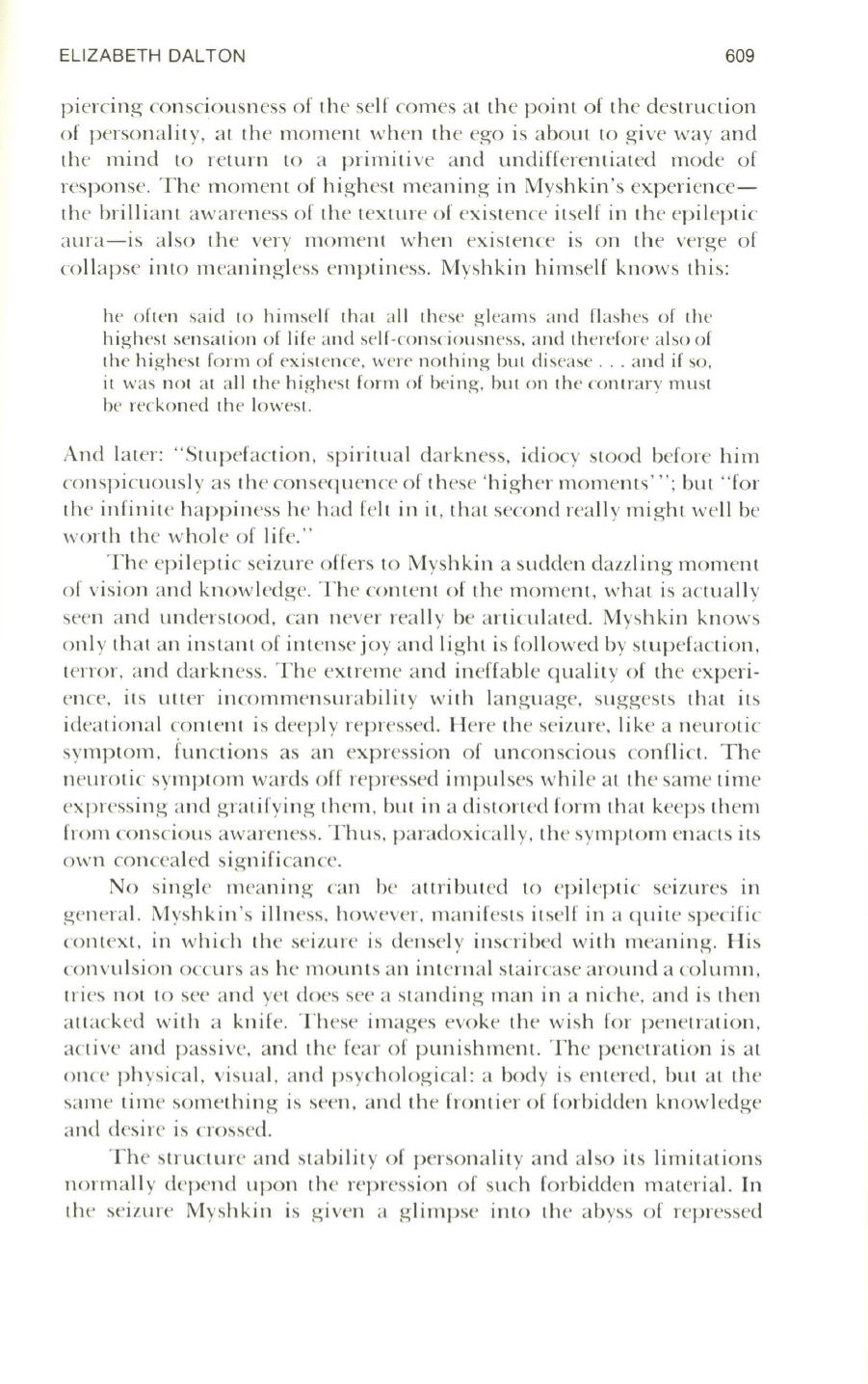
ELIZABETH DALTON
609
p iercing con scio usn ess of th e se lf comes m the po int of the d estructi on
o f person a lit y, a t th e moment when th e ego is a bout to g ive way and
the mind to return to a primiti ve and undifferenti a ted mode o f
response. T h e moment of hi ghest meaning in Myshkin 's experi en ce–
th e brilli ant awaren ess o f the tex tu re o f exi stence itse lf in the epil eptic
a ura-is a lso the very moment wh en ex isten ce is on the verge o f
co ll a p se into meanin gless emptin ess. Myshkin himself knows thi s:
he o ft en sa id
10
himself th a t a ll th ese gleams and fl ashes o f the
high est sensa li o n of life and self-conscio usn ess, a nd th erefore a lso o f
th e hi g hesl fo rm o f exi stence. were nothin g but di sease ... and if so,
il was nOI a l a ll th e hi gh est form of being, bUI o n Ih e contra r y must
be recko ned th e lowest.
And la ter: " Stupefacti on , spiritua l da rkn ess, idi ocy stood before him
con spi cuous ly as th e con sequen ce of these 'hi gh er
moment~ ' '' ;
but " fo r
th e infinite happiness h e had felt in it , th at second rea ll y mi ght well be
wo rth the whol e of life."
Th e epil eptic seizure offers to Mys hkin a sudden dazzlin g moment
o f vision and knowl edge. T he content of th e moment, wh a t is actu a ll y
seen and understood , can never rea ll y be a rti cul a ted. Myshkin knows
onl y tha t an instant of inten se joy and li ght is fo ll owed by stupefaction ,
terro r, and da rkness. Th e extreme and in effa bl e quality of the experi–
en ce, its utter in commen sura bility with language, sugges ts th a t its
idea tion a l content is deepl y repressed. Here the seizure. like a neuroti c
symptom , fun cti on s as an express ion of un con scious confli ct. The
n euro ti c symptom wards o ff repressed impul ses whil e at the same time
exp ress in g a nd g ra tifying th em , but in a di sto rted form th a t keep s them
from conscious awa reness. T hus, p a radoxi ca ll y, the symp tom en acts its
own con cealed signifi can ce.
No sing le meaning can be a ttributed to epil eptic seizures in
genera l. Mys hkin 's illn ess. however, manifests itself in a quite specifi c
context , in whi ch the se izure is den sely in scribed with meanin g. His
convul sion occurs as h e mo unts an interna l sta ircase aro und a column ,
tri es no t to see and yet does see a standin g man in a ni ch e, and is then
a tt acked with a knife. Th ese images evo ke th e wish fo r pen etra ti on ,
act ive and p assive, and the fea r o f puni shment. The penetra ti on is at
once ph ys ica l, vi sua l, and p sycho log ica l: a body is entered , but a t th e
same time somethin g is seen , and the fronti er o f fo rbidden kn owl edge
and d es ire is crossed .
T h e structure and sta bility of person a lity and also its limitati on s
no rma l
I
y depend upo n th e repress ion o f such fo rbidden ma teri a l. In
the seizure Myshkin is g iven a glimpse into the abyss o f repressed


